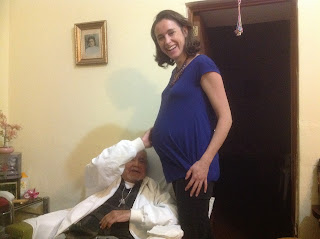Very old and rare tequilas
Sergio Mendoza at the distillery ‘Tequileña’
On
a recent trip to Tequila town, I had the grand experience to try some very old,
rare tequilas at my friend’s family’s distillery. Sergio Mendoza works with his
family on the brand Fuenteseca. This is made at their distillery, ‘Tequileña’,
[NOM 1146] in the town of Tequila. The
family have been running the distillery since 1980 and have been ‘agaveros’,
agave farmers for 5 generations. Enrique Fonseca, Sergio’s uncle is the Master
Distiller and Blender.
The
barrels used for ageing are French Limousin, Nevers, Slovak (primarily used
barrels from Burgundy, Cognac/Armagnac, and other varieties of wines) and small
percentages of White American Oak.
I
began my tasting with their tequila just off the still at 55% abv:
Nose: tropical yellow fruits, acetone
[this is good by the way],cereal [agave?] = wood fibers?, green papaya,
alcohol, lily flower, gardenia
Palate: the same as the nose with the
flowers coming at the end
Next
I tried their 9 year, 43% tequila:
Nose: sherry, old wood, red stewed
fruit, nutmeg, caramel, ripe tropical fruit
Palate: wood, fruit, dry
The
next was their 12 year, 45%:
Nose: vanilla, creme caramel, dried coconut
Palate: creamy, sharp, bright fruits,
finishes dry with spice [pepper], fruit at end is deeper
Next
was an 18 year, 45%:
Lighter
in color than the 12 year old
Nose: lower, more closed than the 12
year old, water like minerality, cedar, vegetable perfume
Palate: light, fine, surprisingly fresh
for its age, good integration of alcohol, burnt orange zest
The
following are comments from Sergio to me.
Fuenteseca is the root word from where our last name,
Fonseca, originates. The tequilas you tasted are the oldest tequilas ever to be
bottled. Some of them predate the CRT regulation for ageing. Each batch is
unique in the sense that they come from a single harvest/vintage, that is, they
are not blended from different vintages, but everything in each bottle comes
from a single harvest. That said, there might always be new batches of the
Fuenteseca 9 Year, but they will come from other harvests, so the actual year
of harvest, more so than the age, is the most important information on the
label.
The tequilas you tried are
- 9 year - Cosecha 2003
- 12 year - Cosecha 2001
- 18 Year - Cosecha 1995
Additionally we have a
- 7 year - Cosecha 2005
- 15 year - Cosecha 1998 (my favorite)
- 21 year - Cosecha 1993
Thank you my friend Sergio. Anybody interested in these
tequilas can contact Sergio directly at:
smg@donfulano.com

















































